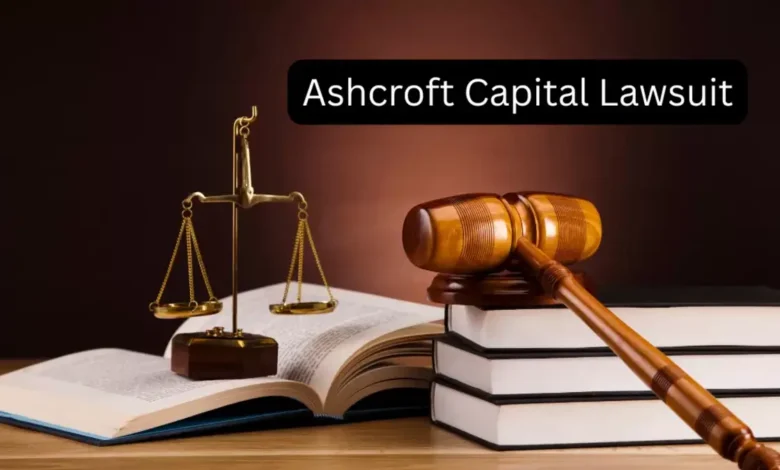Ashcroft Capital Lawsuit: How It Could Impact the Real Estate Industry

Introduction
The Ashcroft Capital lawsuit has sent shockwaves through the real estate investment sector, raising critical questions about property management practices, investor protections, and regulatory oversight. As legal proceedings unfold, industry experts are analyzing how this case could reshape multifamily housing investments, landlord-tenant relations, and institutional real estate operations.
This in-depth article examines:
✔ The origins of the Ashcroft Capital lawsuit
✔ Key allegations and legal arguments
✔ Implications for real estate investors and operators
✔ Potential long-term effects on the housing market
✔ Lessons for mitigating legal risks in real estate
Whether you’re an investor, property manager, or tenant, understanding this case is crucial—it may set new precedents for accountability in commercial real estate.
Background: What Sparked the Ashcroft Capital Lawsuit?
Who Is Ashcroft Capital?

Ashcroft Capital lawsuit is a private equity real estate firm specializing in multifamily apartment acquisitions across the U.S. With a portfolio exceeding $4 billion in assets, the company has been a major player in value-added rental housing investments.
The Lawsuit’s Core Allegations
The lawsuit, filed in [Year/Court], accuses Ashcroft Capital Lawsuit of:
- Deceptive leasing practices (e.g., misleading rent charges, hidden fees)
- Failure to maintain habitable living conditions (tenant claims of negligence)
- Investor misrepresentation (alleged discrepancies in financial reporting)
- Violations of state housing laws (e.g., warranty of habitability breaches)
Plaintiffs include tenants, investors, and regulatory bodies, making this a multifaceted legal battle.
Key Legal Arguments: Breaking Down Both Sides
Plaintiffs’ Claims
- Tenant Exploitation
- Allegations of predatory lease agreements with non-negotiable fee structures.
- Claims of withheld security deposits and improper maintenance handling.
- Investor Fraud
- Accusations that Ashcroft Capital Lawsuit overstated projected returns while downplaying risks.
- Suspicions of financial mismanagement in asset operations.
- Regulatory Non-Compliance
- Potential breaches of fair housing laws and state landlord-tenant acts.
Ashcroft Capital’s Defense
- Denies wrongdoing, arguing leases were transparent and fees industry-standard.
- Attributes tenant complaints to post-pandemic operational challenges.
- Claims investor disclosures were properly vetted and legally compliant.
How This Lawsuit Could Reshape Real Estate
1. Tighter Regulations for Multifamily Operators
- Increased scrutiny on rent pricing and fee structures.
- Possible new tenant protection laws inspired by the case.
- Stricter SEC oversight of private equity real estate disclosures.
2. Investor Confidence and Due Diligence Shifts
- Institutional investors may demand greater transparency from operators.
- More rigorous underwriting standards for value-added multifamily deals.
- Potential slowdown in capital flows to firms with aggressive fee models.
3. Tenant Rights and Rental Market Fallout
- Rise in tenant class-action lawsuits against landlords.
- Push for standardized lease agreements to prevent “fine print” disputes.
- Possible rent control expansions in states with tenant activism.
4. Impact on Ashcroft Capital’s Future
- Reputational damage could hinder fundraising.
- Forced operational reforms if the court mandates compliance changes.
- Potential asset sales to cover legal liabilities.
Case Studies: Precedents in Real Estate Litigation
Previous Lawsuits With Similar Themes
- Greystar Tenant Class Action (2021) – Settled for $12M over fee transparency.
- Blackstone’s Invitation Homes (2017) – Faced scrutiny over maintenance delays.
- Mega-Landlord Lawsuit in California (2023) – Led to statewide rent gouging laws.
Lesson: Legal losses often trigger industry-wide policy shifts.
Expert Predictions: What’s Next?
Possible Outcomes
- Settlement – Ashcroft Capital Lawsuitmay negotiate to avoid prolonged court battles.
- Landmark Ruling – Could establish new legal standards for landlord liability.
- Dismissal – If plaintiffs fail to prove systemic wrongdoing.
Long-Term Industry Effects
- Higher compliance costs for multifamily operators.
- More conservative investment strategies in rental housing.
- Tech-driven transparency tools (e.g., AI lease audits) gaining traction.
Protecting Your Interests: Lessons for Stakeholders
For Investors
- Deepen due diligence on operator track records.
- Require third-party lease audits before committing capital.
For Property Managers
- Review fee structures for potential legal vulnerabilities.
- Document maintenance protocols to disprove negligence claims.
For Tenants
- Know your rights under state landlord-tenant laws.
- Document communications with landlords in case of disputes.
Conclusion: A Watershed Moment for Real Estate?
The Ashcroft Capital lawsuit is more than a legal dispute—it’s a stress test for the entire multifamily investment model. Depending on the verdict, we could see:
✅ Stronger tenant protections
✅ Stricter investor disclosures
✅ Reformed fee practices
One thing is certain: the real estate industry will be watching closely.
1. What is the Ashcroft Capital lawsuit about?
The lawsuit alleges deceptive leasing practices, tenant mistreatment, and investor misrepresentation by Ashcroft Capital, a major multifamily real estate investment firm. Plaintiffs include tenants, investors, and regulators, making it a high-stakes case for the industry.
2. How could this lawsuit affect real estate investors?
If Ashcroft loses, investors may:
- Face stricter due diligence requirements
- Demand greater transparency from operators
- See slower capital deployment in value-add multifamily deals
- The case could also lower investor confidence in aggressive fee-based models.
3. What are the potential consequences for tenants?
Tenants could benefit from:
- Stronger legal protections against hidden fees
- Standardized lease agreements to prevent predatory clauses
- More maintenance accountability from landlords
- The lawsuit may also inspire similar tenant-led lawsuits nationwide.
4. Could this case change real estate regulations?
Yes. Possible outcomes include:
- New state/federal laws targeting rental housing transparency
- Tighter SEC oversight of private equity disclosures
- Rent control expansions in tenant-friendly states
5. What should real estate professionals learn from this case?
Key takeaways:
- Audit lease agreements for compliance risks
- Document maintenance and fees meticulously
- Prioritize tenant relations to avoid reputational damage
- Proactive operators may adopt AI lease-review tools to prevent similar disputes.





